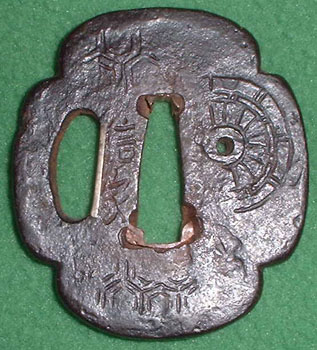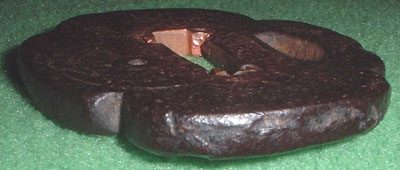But we don't appreciate such designed tekkotsu even if it is very visible. We appreciate a natural feeling.
An example of fake tekkotsu


The signature is "Nobuie"
This is a product in 19th century copying the Nobuie style in 16th century. But the signature may be put recently. It has very uneven surface on the rim, but it is not tekkotsu. It is designed by the tsuba maker.
The top of the tekkotsu-like rib is not smooth as natural tekkotsu. It doesn't look made by long time wearing. Probably the maker wanted to express a powerful feeling, but it looks too much.
I can think out several methods of the tsuba with natural tekkotsu.
1)
Tsuba is not a blade, therefore the material is not necessary to be as fine as for the blade. Cheaper steel may be enough to make a simple tsuba. One ingot of TAMAHAGANE does not have a uniform quality inside of itself. And in the cheaper tamahagane, the differences are bigger. Rough quality of tamahagane and a few times fold welding, such method may remain the uneven hardness in a tsuba plate.
2)
In a work shop of a blacksmith for tsuba/armor, there is always a lot of small cut-out pieces that came from tsuba/armor making process. In old days, smiths did not throw them away because iron/steel was very expensive. So they should keep them and used them again as the material, sometimes for tsuba.
Welding such small pieces together, and fold it a few times. It may be good enough for a tsuba, because every piece is already refined by fold welding when it was used to make armors. Such steel can become a fine plate although of uneven quality .
3)
After 16th century, some iron tsubas were made of three layered steel, a sandwich like construction. Both the surface/outer steels are fine, while the core is not. Such tsuba has a long furrow lined tekkotsu on the rim.